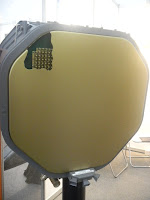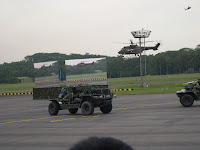I took my time off to touring both places as mentioned above as 29 May 2011 is a International Museum day which is free to all musuems. However I managed to get all stuffs like camera/video, waterbottle, cap, etc and leave home at about 11am and it was quite a short distance from my place appropriately take about 15 mins to Old Fort Factory from Clementi Mrt bus stop to take bus no 184 to reach the destination.


Ford Motor Works (now as Ford Factory), the site where British signed surrender document on 15 Feb 1942
Short Brief History: The Old Ford Factory situated along Upper Bukit Timah Rd, was Ford Motor Waorks Company's first Southeast Asia car assembly plant opened in October 1941. It is today a prominent historical and architectural landmark in S'pore, most remembered as the site where the British surrendered S'pore to the Japanese on 15 February 1942. During the war, it was used as a servicing depot for Japanese Army vehicles and also produced Nissan trucks. After the Japanese surrendered in 1945, the factory resumed operations in 1947. Then It closed down in 1980. The site was then renamed Hong Industries Building and rented out to carious occupants, the last being Bridgestone, the tyre manufacturer. Restored by National Archives of S'pore and gazetted as a national monument in 2006. Memories now houses a permanent WWII exhibition gallery and archives repositories. It is also the first 'Green Mark' certified national monument in S'pore.
 Reception
ReceptionThe main gallery, there are oral history anecdotes and fascinating photographs and artefacts to an emotional journey through the 44 months of Occupation. Nation cards, Identity cards and Japanese lottery tickets will no longer be heresay. Diaries and Cookbooks of Prisoners of War (POWs) reveal their joys and sorrows during internment. While innocent people had to endure untold hardships during the Occupation, they did not succumb to them. Many overcame adversities with clever improvisational and unwavering determination. Have you ever considered using coconut husks to make stools? Or eating tapioca skin as if it was noodles?


Main Gallery & Artefacts
Walked into the entrance, was the reception, on the left, the words came alive 'Syonan Years: Singapore under Japanese rule (1942-1945)'. Beside the main gallery, there is an artefact display (see above) which revealed the past of the Terrifying Last Days. I noticed the board of the other side of the reception stated: "Shouldn't the Japanese WWII artefacts be returned" written by Koji NODA on TODAY 16 Sept 2006. Koji NODA has visited Old Ford Factory in 2006 and Old Ford Factory was gazetted the national monument of its history on the 64th anniversary of the surrender on 15 Feb 2006.


Messenger bag & Headset and Grenades


Pistol and Morse codes sender
Along the pathway gallery, on right side of the wall, there are artefacts on display which Japanese armies used during the war - 1)A messenger bag & Communication set that used to convey message during the war, 2) Replicas of Grenades, 3) Replicas of a pistol, 4) A Morse code sender ..etc (see pic above).

Out of curiously, I saw a 'red' chair and bicycle that used by British and Japanese during war. The 'Red' chair was from Supreme Court symbolising transfer of British seat of power to the Japanese with the establishment of the Japanese judicial system. The Bicycles were the main mode of transport for the Japanese during the Malayan Campaign. Even during the Occupation it remained so for the locals as vehicles were confiscated by the Japanese.
 Lt Gen Percival & Lt Gen Yamashita
Lt Gen Percival & Lt Gen YamashitaOn the corner of my eyes facing the window that shone brightly, I saw two statues stood on side by side on each other were none other than Lieutenant - Gen. Arthur Ernest Percival (left) and Lieutenant - Gen. Yamashita Tomoyuki. Short Brief of Gen. A.E.Percival - After the fall of S'pore, Gen. A.E. Percival spent a brief time in Changi Prison before he was removed to a Japanese Prisoner-of-war camp in Manchuria where he remained in captivity until the end of Second World War. He was later flown to Tokyo Bay to witness the Japanese Surrender on 2 Sept 1945. A.E. Percival retired from the army in 1946 and published a memoir 'The War in Malaya in 1949'. He held various appointments and died at the age of 78 on 31 Jan 1966.
Short brief of Gen. Yamashita Tomoyuki - better known as 'Tiger of Malaya" for his victorious campaign against the British in Malaya. He was regarded by many as a man of foreboding presence, not tall and was very fierce-looking. When he went round the ward, he was striding round and his sword fluffing at his side. It was rather frightening. Following the Japanese surrender in 1945, Yamashita was tried and sentenced to death in Manila, Philippines for war crimes relating to the Manila Massacre.
So much history of the past at Old Ford Factory which you may not see the sufferings of the people during the wartime especially food shortages and water as well as vehicles were confiscated at the start of the Occupation and also due to the shortage of petrol. Only a resident doctor was allowed to keep his car which was marked with a black cross, stated: "That car became a car to everyone if there was somebody sick and had to be taken to hospital, a doctor get permission for them to take his car and the old lady or whoever to the hospital. Or if somebody died, it was used even like a hearse. And if there was a wedding during that time, it was used as a bridal car. So it was a car that was used by that little community around. And when people went to Yio Chu Kang, people used to remove the seats and piled it with all these coconuts and things like that.


Lim Bo Seng (alias Tan Choon Lim) - born 27 Apr 1909 and died 29 Jun 1944 (age 34)
And there is also some artefacts display in this showcase on top of the wall - The sword, wartime journal and Lim Bo Seng's handwritten diary. These items were belonged to key Force 136 members, Lim Bo Seng and Than Sien Yen, their diaries were documented their thoughts during the Japanese Occupation years and a sword was given to Tham Sien Yen after the war by the British, in recognition of his wartime efforts.
When the British returned to Malaya in 1945, his body was brought back to Singapore. He was buried with military honous at MacRitchie Reservoir on 13 Jan 1946. A Memorial Service was held at the steps of the Municipal Builiding (City Hall). The memorial at MacRitchie Rerservoir was erected on 27 Jun 1952 by the Lim Bo Seng Memorial Committee. A sum of Hong Kong $85,000 was raised to erect the pagoda at the Esplanade; it was officially unveiled in 1954.


Another showcase are Denominations of banana money, lottery tickets and a cheque book from Ban Hin Lee Bank during the Occupations (1st pic above). And the Bucket night soil system (2nd pic above) was used by Ms Barbara Scharnhorst, when she was eight year during the Occupation, during her interview on Apr 2006 - There were no flush system and was like the bucket night-soil system that the guys would come and pick it up at night. She was so afraid that while she was in the bathroom, the guys going to come and take the can. She was so afraid she was going to see a hand coming under. She used to cry and not want to go to the bathroom because it was so 'yuck'. Then she would have stomach problems because she did want to go to the bathroom. Then her mother would say, 'You have to because otherwise you're going to get sick.' Her mother would take this castor oil and stuff like that gave her to drink so that she had to go to the bathroom. But it was really awful.
 .
.Furthermore, there is 'The Civilian War Memorial' display on the wall indicated the place called Japanese Cemetery Park in Chuan Hoe Road where the Japanese war dead in S'pore are buried, among other Japanese esidents who had died before the war. I believe that you might have seen the inscription on the 70-cm high marker when you visited Japanese Memorial Park, that reads: "A memorial to the ashes of 135 martyrs" and on the back of the marker is an inscription that reads: "Provisionally buried at Changi. They gave their lives to the Emperor." Also there is similar inscription marker on the stone that reads "A soldier of the Indian Army (1939-1945) is honoured here."


I think I have to go outside to look for a stone which I saw in the gallery on the wall. There, I found it at the corner of the Memories Green sits a granite stone inscribed with a statement of Zhenguan Zhenhyao (Tang Dynasty): "Taking History as a Lesson" on a consquence of war in these inspiring words (Tranlate from Chinese): "With a bronze mirror, one can see whether he is properly attired; With history as a mirror, one can understand the rise and fall of a nation; With a man as a mirror, one can see whether he is right or wrong." And there is also 'He Ping' sculpture at Memories Green. The name of the two words mean 'Peace' which stands out on this factory compound, which marked the start of the Japanese Occupation.


Along the side the building, there is a 'Tic-Tac-Toe the game the relates the facts and figures about Japanese Occupation and also the Syonan Garden where the padi plot and food crops such as yam and tapioca that were commonly grown during the Occupation to overcome food shortages. Also the outside the building, there ia a Syonan Race where the life during the Occupation years unfolds the 44 boxes of colourful visuals captured in this gigantic and localised version of Snakes & Ladders.


At last but not least, there is AV Theatre upstairs, just outside the corridor of the building to the left, you can watch
and listen to the history about the war and sufferings during the Occupations.
Well, I have to pen off here and there is much more to come..."Reflections of Bukit Chandu & Changi Museum" in my next writeup.































